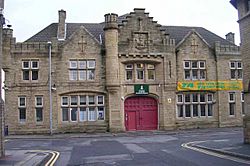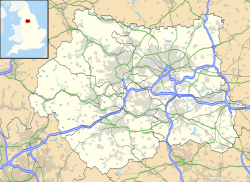St Paul's Street drill hall, Huddersfield facts for kids
Quick facts for kids St Paul's Street drill hall |
|
|---|---|
| Huddersfield | |

St Paul's Street drill hall
|
|
|
Location in West Yorkshire
|
|
| Coordinates | 53°38′33″N 1°46′37″W / 53.64255°N 1.77686°W |
| Type | Drill hall |
| Site history | |
| Built | 1899–1901 |
| Built for | War Office |
| In use | 1901–Present |
| Garrison information | |
| Occupants | Corunna Company, 4th Battalion, The Yorkshire Regiment |
The St Paul's Street drill hall is a special building in Huddersfield, West Yorkshire. It's like a training center for soldiers. This building is very old and important, so it's a Grade II listed building. This means it's protected because of its history and unique design.
Contents
The St Paul's Street Drill Hall
This drill hall has been a busy place for over 120 years. It has seen many soldiers train and prepare for their duties. It's an important part of Huddersfield's history.
Early Days and World War I
The drill hall was built a long time ago, between 1899 and 1901. It was designed by Captain Willey Cooper. It was meant to be the main base for a group of soldiers called the 2nd Volunteer Battalion, The Duke of Wellington's Regiment.
A very famous soldier, Field Marshal Lord Roberts, officially opened the building in May 1901.
In 1908, this group of soldiers changed its name to the 5th Battalion, The Duke of Wellington's Regiment. When World War I started in August 1914, these soldiers were called to action at the drill hall. They then went to fight on the Western Front, which was a major battle area in Europe.
Changes During World War II
Over the years, the types of soldiers and their jobs changed. In 1936, the 5th Battalion became the 43rd (5th Duke of Wellington's Regiment) Anti-Aircraft Battalion, Royal Engineers. This means they specialized in defending against enemy planes.
During World War II, in 1944, they changed again. They became the 600th Regiment, Royal Artillery (5th Battalion The Duke of Wellington's Regiment). After the war, in 1947, they were known as the 578th (5th Battalion The Duke of Wellington's) Heavy Anti-Aircraft Regiment, Royal Artillery. These names show how their roles in the army kept evolving.
Post-War and Modern Times
In 1955, this unit joined forces with another group called the 382nd Medium Regiment, Royal Artillery (Duke of Wellington's Regiment). Later, in 1961, they became the West Riding Battalion, The Duke of Wellington's Regiment (West Riding) back in Huddersfield.
After some army changes in 1967, soldiers returned to the St Paul's Street drill hall in 1971. This new group was C (The Duke of Wellington's Regiment) Company, 3rd Battalion, Yorkshire Volunteers.
This company also changed names several times:
- In 1993, they became C Company, 3rd Battalion, The Duke of Wellington's Regiment (West Riding) (Yorkshire Volunteers).
- In 1999, they were called Ypres Company (Duke of Wellington's Regiment), The East and West Riding Regiment.
- Finally, in 2006, they became Corunna Company, 4th Battalion, The Yorkshire Regiment.
Today, the St Paul's Street drill hall is still a busy place. It serves as an active Army Reserve Centre. This means it's a place where part-time soldiers train to support the full-time army.


